ABSTRACT:
Placing customers at the center is fundamental to the success of any business. But, with time, changing customer preferences, and advancing technologies, businesses have to constantly re-strategize to deliver remarkable customer experience.
Customer experience management (CXM or CEM) is the top-most business discipline. It helps businesses engage customers to the maximum level, offering exceptional experiences by delivering the best products and services. With a customer-centric approach, businesses can offer end-to-end customer services via multiple channels and drive customer retention and business growth.
However, as the experience is subjective, delivering exceptional customer experience at every touch point is getting a bit challenging. Businesses have to make the experience easy and satisfying and match the customers' needs every time. This demands a measurement-based approach. Customer experience management systems are gaining popularity for this reason.
GoodFirms’ survey ‘Customer Experience Management Market: Industry Demand, Top Trends, and Future Scope’ is an attempt to gain insights into the industry demand and current trends in the market. The survey also aims to predict the future scope of the customer experience industry while pointing out its challenges.
Table of Contents:
Overview of Customer Experience Management
Top Customer Experience Strategies Adopted by Businesses
- Understanding the Audience
- Personalized Experience
- User-friendly UX/UI
- Improving Customer Support
- Mapping Customer Journey
- Prioritizing Omni-Channel Presence
- Implementing Technologies like AI/ML
- Enhance Social Listening
- Empowering Frontline Employees
Benefits of Customer Experience Management
- Higher Customer Retention
- Better Customer Satisfaction
- Enhanced Customer Engagement
- Build Trust Among Customers
- Rise in Revenue
- Improved Brand Image
- Higher Customer Acquisition
Challenges When Implementing CX Strategies
- Proper Communication with the Customer
- Tracking Conversational History of the Customer
- Having an efficient Omni Channel Presence
- Organizational Silos
- Inadequate and Flawed Data Collection
- Lack of Commitment from Leadership
- Limited Funding
Introduction
Customer experience is anything and everything that brands do to put their customers in the first place. Customer experience management deals with the strategy adopted by brands to meet the expectations of the customer with respect to their interaction with the brand.
But, with changing times and with multiple brands up in the showcase, customers today expect a better experience during their entire journey apart from the cost factor. This changing attitude of customers is forcing brands to adopt better strategies that can facilitate a smooth and frictionless customer experience. The emergence of technologies like generative AI and AR/VR is elevating brands' efforts to improve their customer experience strategies.
Although customer experience management has been gaining popularity for a long time, there are several challenges that make it difficult for brands to attain customer satisfaction.
GoodFirms’ research, ‘Customer Experience Management Market: Industry Demand, Top Trends, and Future Scope,’ is an attempt to gain insights into strategies brands are adopting to satisfy their customers. The research also aims to shed light on the top trends in the customer experience management industry and its future scope.
Overview of Customer Experience Management
Customer experience management (CXM or CEM) is a practice that allows businesses to focus exactly on the end-to-end experiences and fulfillment of the customers across multiple channels. Customer experience management is directly related to customer retention, and thus it acts as a linchpin to any business. With a number of challenges to overcome, brands need to come up with diverse tactics to attain utmost customer satisfaction.
Why Does CXM Matter?
CXM, or customer experience management, is the key to revenue. It is the golden boon that can fetch positive results when executed properly. This demands brands to offer more than just their products and services. It deals with customer engagement, customer satisfaction, customer service, and customer experience by managing interactions with customers across all physical and digital channels.
Today, CXM is considered to be an organic attempt to deliver seamless services to customers while improving brand loyalty and enhancing customer acquisition. Customer experience management places customers at the center point, allowing brands to manage customer interactions to meet or exceed customer expectations and improve brand trust and advocacy.
Nitish Garg of IdeaUsher says, “Customer experience, in my view, is the sum of feelings, perceptions, and interactions a customer has with a brand. It's about creating moments of delight and satisfaction throughout their journey, ultimately fostering loyalty and trust.”
Customer experience management is critical today as it helps brands/businesses maintain a competitive edge, churn satisfied customers, enhance communication with the users, be loyal, and make informed decisions.
Customer Experience Management Market Size
The global customer experience management market accounted for USD 14.95 billion in the year 2022 and is estimated to reach a value of USD 52.54 billion by the year 2030 with a CAGR of 16.6% during the forecast period. (1)
The market growth is fueled by collaboration with emerging technologies like augmented reality and artificial intelligence in customer experience solutions. One of the major factors that contribute to the market growth is the rising trend of online shopping, supporting technologies like customer experience management software, and the use of AI in customer experience management processes.
Survey Data and Analysis
GoodFirms’ survey titled “Customer Experience Management: Industry Demands, Trends, and Future Scope,” conducted in October 2023, gives an idea about the industry and the factors driving its growth. The survey also gathers insights into the trends and setbacks in the industry. The survey also aims to give an idea about the transformations of the industry and the responsible factors for the transformation.
The survey queried 485 businesses, which included sellers, retailers, suppliers, and consumers.
53.2% Of Businesses Have A Dedicated Customer Experience Management Team
The popularity of customer experience management is growing rapidly as businesses have been seeing the benefits in terms of customer retention and improved sales. Around 53.2% of the surveyed businesses already have a dedicated customer experience team, while 29.5% of businesses are likely to have one once they have a significant customer base.

But, alarmingly, nearly 17.3% of the surveyed businesses do not have a dedicated team for customer experience management still.
Top Customer Experience Strategies Adopted by Businesses
With the growing importance of customer experience, most brands are working towards improving their CX efforts. Although not every customer experience strategy works for all businesses alike, there are some CX efforts that are popular among businesses.
“Fast reaction, personal approach, reward, transparency on every stage result in an exceptional customer experience,” says Nika Paramonova of Galaxy4Games.

Understanding the Audience
Around 79.5% of survey respondents feel that understanding the audience is a major strategy for implementing customer experience management.
Understanding the target audience is the foremost step to offering a great customer experience. Identifying and knowing the target audience can help businesses in multiple ways.
A proper understanding of the audience is essential to developing a customer-centric approach for a business. Looking at the demographics like age, gender, location of customers, their past buying preferences, etc., gives clarity about customers' current preferences. Keeping track of customer expectations and changing customer behavior is critical to providing a seamless buying journey and offering an excellent customer experience.

Understanding the customer is a breakthrough for brands to know the needs of their customers. With effective communication and an understanding of the audience, businesses can create a roadmap for sales and marketing strategies.
Personalized Experience
Providing personalized experience is one of the highly implemented strategies to deliver a great customer experience for 71.9% of businesses.
Personalization has become an essential aspect of changing consumers’ expectations. Personalization of customer experiences is the key to customer acquisition and retention.
Offering personalized customer experiences makes the customer feel valued, which in turn leads to the brands' advocacy. Interestingly, faster-growing companies that offer personalization in their services drive 40% of their revenue from personalization.(2)
Andrei Neacsu of HyperSense Software Inc. believes, “Tailored interactions based on customer preferences, user-friendly platforms, proactive engagement, and responsive customer support are key for a great customer experience.”
Consumers now demand personalization, and offering it from the beginning of their buying journey can result in a pleasant experience.
User-friendly UX/UI
For 63.1% of surveyed businesses, having a user-friendly UX/UI can help in having an efficient customer experience management process.
With the world going online, an online presence with an impressive website has become a prime touch point for any business to connect with its customers. A great website with user-friendly UX/UI can offer a great customer experience for a customer.
A study claims that 97% of the websites are encountered with at least one major accessibility error. (3) These accessibility issues can be a significant factor affecting the customer's perception of the business.
A responsive, user-friendly, easy-to-navigate, and aesthetically pleasing website is a must to improve the customer experience of the website.
Improving Customer Support
Improving customer support is one of the most effective ways to implement a customer experience strategy, according to 61.7% of surveyees.
Customer support or customer service is the backbone of customer experience. Responding promptly to customer queries and providing the required information is an essential part of a good customer experience.
Anna Rozhenstova of Timspark mentioned an incident where they dealt with a client from the restaurant industry, “To avoid customer dissatisfaction and maintain a positive client relationship, we set up a meeting where the client expressed their concerns about the app's limited payment functionality and described their expectations. To ensure that the app remains competitive with the new payment features, we conducted thorough market research. We explored how restaurant visitors make NFC payments in other mobile apps.”
Efficient customer support drives consumers to a particular brand. According to a Salesforce report, 78% of consumers are willing to buy from a brand even after a mistake if the brand offers excellent customer service.(4)
Real-time and friendly communication, faster resolution to queries, and owning responsibilities by the customer service team lead to a great customer experience.
Mapping Customer Journey
Around 54.3% of survey respondents said that mapping the customer journey is a major strategy to deliver a good customer experience.
Customer journey mapping is the visualization of the interactions the customer has with the business and their perception of the brand during those interactions.
A customer journey map is an essential tool to understand the pain points of the customers and decide on the measures to make the customer journey satisfying. It helps in pointing out the inefficient processes and policies that are troublesome from the view of a consumer. The proactive approach from brands to eliminate the points that can frustrate the customers ensures frictionless interaction.
John Pennypacker, VP of Sales and Marketing at Deep Cognition, points out, “Another thing that I've found invaluable in our customer interactions is a strong memory for details. Remembering little facts about your customers can make a big difference in the long run.”
Customer journey maps can also help brands identify the scope for automation and improve the efficiency of business processes. Customer journey mapping stands as a crucial investment for brands focussing on improving customer experience.
Prioritizing Omni-Channel Presence
31.8% of surveyees suggest prioritizing omnichannel presence as a key strategy for better customer experience.
Consumers expect to get in touch with a brand from wherever and whenever they wish to. Online or offline, brands need to have their presence on multiple channels to stay in the competition.
An omnichannel presence with accurate customer data synchronization is critical for a smooth and frictionless customer journey.
“Dealing with customers' subjective experiences can be challenging, but the answer lies in consolidating all communication channels into a single interface. This ensures no customer query goes unnoticed or unanswered, whether it's through email, phone, or social media,” says Steve Pogson, Founder of FirstPier.
Customers expect brands to know them irrespective of the channel they are using. Prioritizing an omnichannel presence is, therefore, crucial for brands willing to improve their customer experience.
Implementing Technologies like AI/ML
29.4% of the surveyed businesses are using technologies like AI/ML to execute exceptional customer experience management.
The introduction of chatbots by an increasing number of brands is an example of faster implementation of technologies like AI and ML. RAG technology is gaining its place in chatbots primarily focused on enhancing customer experiences via hyper-personalization.(5)
Like any other field, the benefits of implementing these technologies are evident in customer experience as well. They are capable of improving the speed at which customer queries are resolved. The use of advanced technologies also allows brands to introduce self-service options to enable them to address issues themselves.
According to Draven, CEO and Founder of Klipboard, “The corporate landscape is woven from innovation and changing client expectations. Businesses must monitor market changes to stay competitive. Technology can accelerate transformation by improving products, services, and the customer experience.”
AI can also help with personalizing a user experience to some extent. Leveraging these technologies can be helpful in improving customer experience.
Around 22.6% of surveyees said that enhancing social listening can help improve customer experience.
Social listening is an effective way for a brand to know consumer sentiments and identify shortcomings from the consumer's point of view. It can help brands identify their strengths and weaknesses.
About 69% of consumers expect that brands must respond within 24 hours after they reach out to them on social media.(6) This indicates the relevance of social media platforms for improving customer experience.
Adopting social listening can also give an idea about the strategies adopted by competitors that can help in understanding the market trends and customer expectations.
Empowering Frontline Employees
Nearly 20.5% of survey respondents feel empowering frontline employees can help in improving customer experience.
Customer care representatives are often unable to solve customer problems due to the lack of authority. When interacting with customers, the delay that is caused in solving the issues due to the required approvals is a reason for frustrating consumers. Empowering frontline employees to make certain decisions based on their understanding can help solve customer queries in real-time.
Acting upon employee feedback regularly is also a great way to meet customer expectations. Empowering employees can also be done by educating them regarding their role in improving the customer experience.
Benefits of Customer Experience Management
Customers are prioritizing the experience a brand offers over the price they are paying nowadays. It is, thus, necessary for brands to adopt an efficient customer experience strategy to leverage several benefits.
GoodFirms’ survey tries to bring to notice the many benefits of adopting customer experience management for businesses.
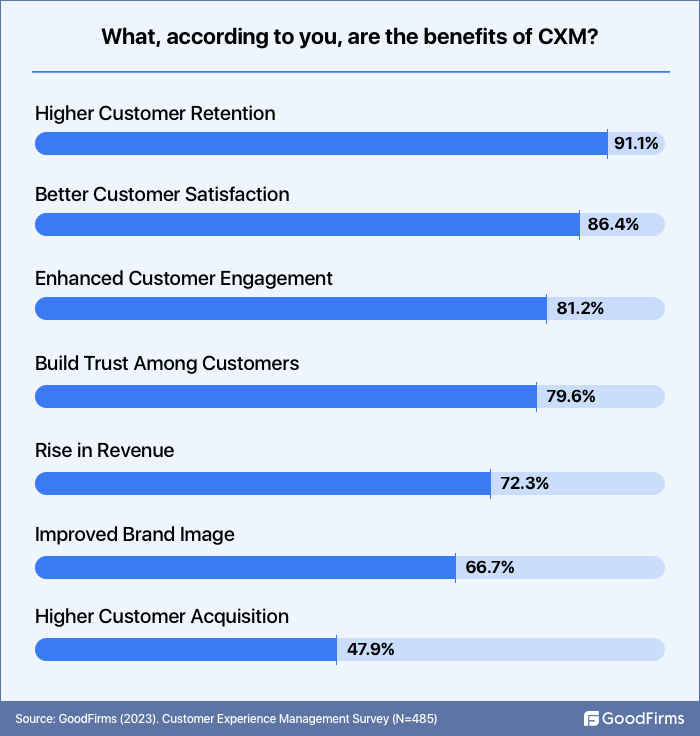
Higher Customer Retention
According to 91.1% of surveyed businesses, a good customer experience brings in higher customer retention.
Better customer experience motivates customers to come back to a brand leading to improved brand loyalty.
Improved brand equity and loyalty are major reasons for higher customer retention. Customer retention is a positive sign for businesses in times of crisis. Higher customer retention is also responsible for higher lifetime value.
Better Customer Satisfaction
Nearly 86.4% of surveyees believe that a better customer experience strategy can lead to better customer satisfaction.
Improved customer experience is associated with improved customer service. Improved customer service also leads to better customer satisfaction.
“Prompt responses to initial inquiries, the well-informed process from the start till the end, consistent communication regardless of working hours, and on-time service delivery make an exceptional customer experience,” says Mark Javed of Innovate360 LDA.
Customer experience deals with the understanding of customer needs, customer preferences, and current industry trends. Incorporating changes in the products and services as per the collected data is a significant contributor to customer satisfaction.
Enhanced Customer Engagement
Enhanced customer engagement is a major benefit of implementing customer experience strategies, according to 81.2% of survey respondents.
A successful customer experience strategy involves the omnichannel presence of the brand. Companies' availability for their customers through multiple channels helps gather insights like customer data and preferences. Customer interactions help in gauging customers’ changing needs.
The omnichannel strategy is helpful in engaging customers by analyzing the most preferred communication channels and being in touch with the customers. It helps in being agile and in offering direct-to-customer allowances. Improving customer interactions through transformative strategies via their preferred channels can help improve brand visibility. Brands can also leverage this customer engagement for branding and implementing suitable marketing campaigns.
Build Trust Among Customers
An efficient customer experience strategy can help in building trust among customers after implementing an effective customer experience strategy, according to 79.6% of businesses.
Excellent quality products and services and timely customer service are the major components of a successful customer experience strategy.
Improved customer service is a major reason for enforcing trust in a brand among customers. When the customers feel valued and listened to, they develop a sense of trust for a brand. This trust among consumers is necessary in times of crisis.
Rise in Revenue
About 72.3% of surveyed businesses believe that a good customer experience strategy results in a rise in revenue.
The improved customer engagement and higher customer retention that is possible due to a better customer experience strategy are directly related to the business revenue growth.
Customer retention leads to higher customer lifetime value which contributes to the rise in revenue. Also, understanding customer preferences and planning sales strategies accordingly can also be beneficial for the business. Moreover, businesses can offer special discounts and promotions based on consumer preferences, leading to higher sales.
Improved Brand Image
Improved brand image is a major benefit of implementing a customer experience strategy, according to 66.7% of surveyees.
An excellent customer experience enforces trust among customers and builds the brand image. The sense of trust among customers motivates them to write positive reviews for the business. In the online world, positive reviews for a brand are crucial to enhance the brand image.
Daniyal Sanaullah, CEO of SocialSharings says, "Customer satisfaction is attainable, and it's crucial for the success of any business. A happy customer is likelier to continue using your services and recommend them to others. Conversely, the consequences of customer dissatisfaction can be severe. It can lead to revenue loss and negatively affect your brand reputation.”
A loyal customer base can be very helpful in enhancing the brand image. Marketing and sales teams can further leverage this trust and image of the company to improve the bottom line of the business.
Higher Customer Acquisition
Nearly 47.9% of businesses believe that customer experience strategy leads to higher customer acquisition.
A good customer experience strategy is great for brand equity. When a customer is satisfied with a brand, the customers' emotions are helpful for building brand equity. This helps leverage a loyal customer base for the brand. Happy customers can bring in more leads. They can promote your brand and perform word-of-mouth (WOM) marketing. They can be your brand ambassadors.
Positive reviews and a loyal customer base can be critical for referrals and to churn brand evangelists. Positive word-of-mouth referrals can lead to customer acquisitions.
Challenges When Implementing CX Strategies
Although implementing customer experience strategies is essential for better sales, businesses have to overcome several challenges to have an efficient customer experience management plan in place.
This survey by GoodFirms helps in knowing the challenges a business can face while implementing customer experience strategies and ways to overcome those challenges.
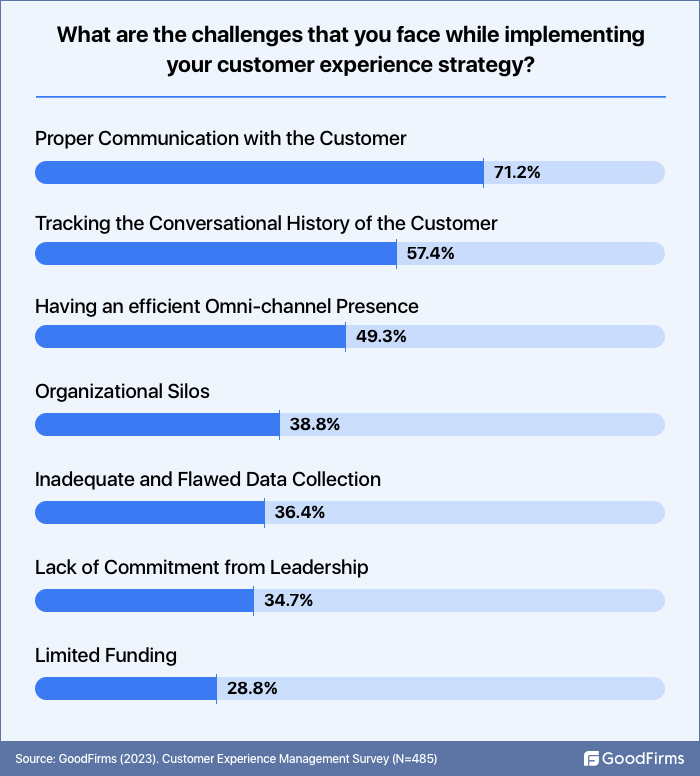
Proper Communication with the Customer
Around 71.2% of the surveyed businesses said that proper communication with the customer is a challenge while implementing a customer experience strategy.
Customer Experience largely depends on the interaction the customer has with a brand. It is, therefore, necessary for businesses to have proper communication with their customers.
However, there are several reasons that communication is hindered. Time zones, language barriers, lack of proper communication tools, and ineffective communication processes are some of the basic challenges faced today. Lack of personalization during the interaction and the need for customers to repeat the information every time they connect with the brand can lead to a poor customer experience.

The use of proper tools and technologies like AI can help improve personalization for customers, resulting in a good customer experience.
Tracking Conversational History of the Customer
According to 57.4% of surveyees, tracking the conversational history of the customer is one of the major challenges when implementing a customer experience strategy.
Customer experience deals with the interaction the customer has with the brand at every touch point during their entire journey. However, when the customer gets in touch with the business through various channels, tracking the conversational history gets difficult.
Having an account of the various instances of customer interactions is essential for the smooth journey of the customer. Having to repeat the same information when conversing gets frustrating for the customers, leading to a bad customer experience.
The use of efficient customer experience software to keep track of customer conversations can be of great help to businesses.
Having an efficient Omni Channel Presence
Having an efficient Omni channel presence is a major challenge for businesses implementing CXM, according to 49.3% of survey respondents.
The omnichannel presence of brands is the need of the hour. Customers demand various channels to get in touch with the brand. While customers have their own preferences for making their purchases and also for customer service requests, creating a positive experience at every channel is a tough job.
Businesses struggle to provide a seamless and consistent customer experience through all the channels. This survey by GoodFirms reveals the level of satisfaction of customer experience through numerous channels.
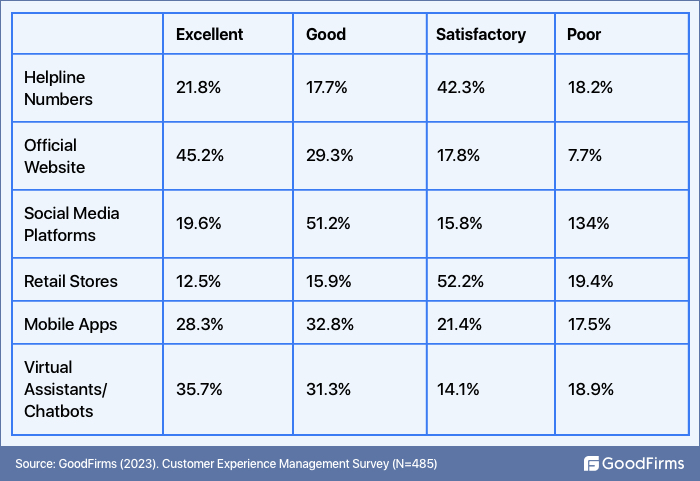
The table shows the level of satisfaction of customers for the customer experience they are providing through various channels. To be ahead in the customer experience game, businesses have to thrive irrespective of the channel to deliver great CX to their customers. While 52.2% prefer to go to a retail store for a better service, and 51.2% are happily connecting with a brand via social media platforms, nearly 36% of the surveyees feel virtual assistants or chatbots are much more efficient, and they are extremely satisfied with the service.
Organizational Silos
Around 38.8% of the surveyed customers said that overcoming organizational silos is a major challenge for delivering a great customer experience.
Delivering a good customer experience has to be a team responsibility. Providing a seamless customer experience can be achieved by the involvement of every single department of a business.
However, organizational silos and the restricted flow of information among departments lead to mismanagement and friction in the customer journey. Departments working in silos may lead to misalignment with the CX goals of the organization. It is necessary for brands to make every department aware of their role in delivering CX to deliver quality products and services to customers.
Developing a customer-first approach in the organization is crucial for overcoming this issue.
According to Nikolai Karelin of Silk Data, “Customer-first approach of the entire team can differentiate your company from its competitors when it comes to Customer Experience.”
Inadequate and Flawed Data Collection
Nearly 36.4% of surveyees said that inadequate and flawed data collection is a challenge for delivering a better customer experience.
A great customer experience can be achieved only through accurate customer data, preferences, and behavior patterns. Inadequate or flawed data collection leads to improper actions and ineffective marketing campaigns.
Improper assessment of the CX efforts can also lead to flawed data regarding the currently implemented CX strategies and mislead the future steps for delivering a desirable customer experience. Collecting regular feedback and effective assessment of the CX strategy helps improve the customer data associated with consumer preferences and requirements.
Implementation of proper data collection and data analytics tools can help businesses have reliable data to work on.
Lack of Commitment from Leadership
Around 34.7% of surveyed businesses face the challenge of a lack of commitment from leadership when implementing CX strategies.
Although delivering customer experience is of utmost importance for staying competitive, resistance from top leadership to investing in CX efforts might be an obstacle for some organizations to have an efficient CX strategy.
Lack of information about the current trends, or negligence, can be responsible for the friction from the top management to implement CX efforts. Aligning CX efforts and organizational goals should be the priority of organizations for enhanced functioning and effortless customer experience.
Limited Funding
Limited funding is a challenge for around 28.8% of businesses when implementing CX strategies.
Along with the commitment from higher management, inadequate funding is also a challenge for companies when adopting CX strategies. This issue arises mainly with smaller organizations.
The perception of businesses to consider customer experience secondary to other business aspects may also be a reason for lesser funding. The employment of a dedicated software solution might be a solution for limited funding to some extent.
The Future of Customer Experience (CX) Management
Implementation of customer experience management strategies has been rising among industries, irrespective of their size and type. The strategies being adopted by a particular company differ from the others based on their target audience, audience preferences, and some other factors.
Like any other sector, customer experience management is also expected to see transformation due to changing customer behavior and advancements in technologies. This survey by GoodFirms shows some areas that can be expected to bring changes in the future.
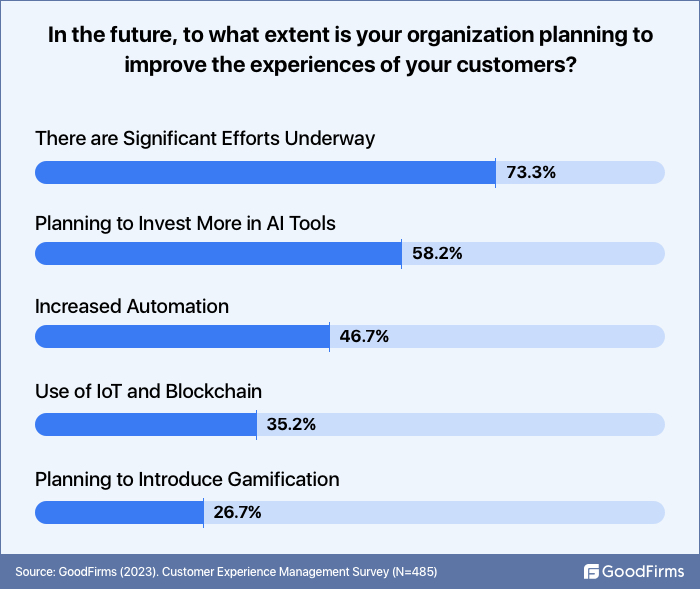
Around 73,3% of businesses believe that they are already making significant efforts to deliver a great customer experience.
Investment in AI
Around 58.2% of survey respondents plan to invest more in AI tools in the future.
Artificial intelligence has touched all sectors, and customer experience is no exception. AI tools can enhance an organization's capability to deliver personalized experiences to its customers. AI-powered customer service could improve the customer experience.
Right from chatbots to suggesting further purchases based on customer preferences, AI can help businesses with personalization for their customers. Interestingly, a survey claims that 63% of customer experience professionals predict the positive impact of AI tools on customer experience.(7)
Increased Automation
46.7% of businesses think they would increase automation in their CEM strategy.
Automation in customer experience is used to automate some monotonous tasks to deliver faster results. Implementation of chatbots, AI, ML, Robotic process automation, and business process automation, to name a few. The use of voice technology with the help of AI assistants can be a great way to automate communication between customers and brands.
Introduction to chatbots can help in automating decision-making that does not require human intervention. Chatbots have significantly reduced the load of customer service teams for smaller issues. Robotic process automation and business process automation are great methods to automate repetitive tasks, small or complex. Automation helps reduce the workload from workforces, enforcing productivity and better customer satisfaction.
Use of IoT and Blockchain
35.2% of businesses hope to implement IoT and Blockchain in their CXM efforts in the future.
The use of IoT technology enables products to communicate within a network. The use of IoT-enabled products is a great way for businesses to manage inventory. Implementation of IoT is also beneficial in maintaining transparency about the quality of a product.
Such products embedded with IoT can help customers with predictive maintenance and also indicate the shelf life of the product. Proactive services for certain products are very effective in delivering an excellent customer experience.
Along with IoT, blockchain technology is also an aid for improving CXM while providing options like the transfer of loyalty points and making hassle-free services available with secure digital currency transfer.(8)
Introduce Gamification
Almost 26.7% of the survey respondents plan to introduce gamification in the customer experience strategies.
Gamification can help brands improve customer engagement. Several brands have already introduced games to keep their customers engaged.
The methods of unlocking rewards after certain levels motivate customers to buy products. Hunting for discounts and offers can bring a bit of entertainment to customers. Rewarding loyalty points is one such practice that shows the significance of gamification in engaging customers and thereby improving the customer experience.(9)
This gamification of services can also be introduced for the employees to keep them motivated. A great employee experience can also lead to a customer experience.
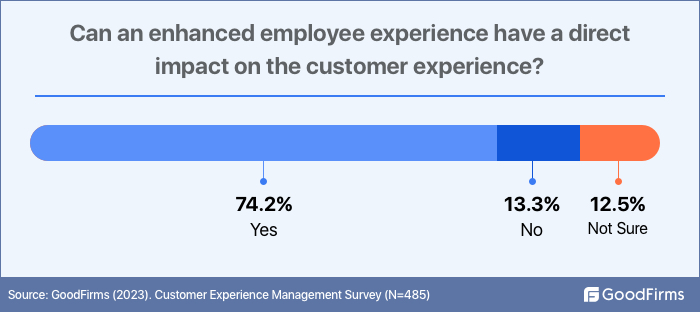
Interestingly, the GoodFirms’ survey reveals that around 74.2% of businesses believe that an enhanced employee experience has a direct impact on the customer experience.
Key Findings
-
CXM is an attempt to deliver seamless services to customers while improving customer satisfaction and loyalty.
-
Although CXM and CRM are closely related, customer experience management largely differs from customer relationship management.
-
About 17.3% of businesses still do not have a dedicated customer experience management team.
-
Around 79.5% of businesses believe that understanding the audience is a major strategy for delivering a great customer experience, while it is providing a personalized experience for 71.9% of businesses.
-
Having a user-friendly UX/UI is a major customer experience strategy for 63.1% of survey respondents.
-
Benefits of CXM for a business include higher customer retention and improved customer satisfaction.
-
Around 71.2% of businesses believe that having proper communication with the customers is a challenge for delivering a great customer experience.
-
The future of the customer experience industry may expect higher investment in AI tools and increased automation.
Conclusion
Satisfied customers are the lifeline of any business. It stands as a competitive advantage and a key differentiator. However, the fast-evolving customer expectations bring a huge challenge for brands. Having satisfied customers can help businesses reach heights, whereas dissatisfied customers can destroy a business. Businesses will have to dramatically re-think their customer experience strategies to accommodate new trends and technologies like artificial intelligence, automation, etc. Brands ready to take this plunge will see benefits in terms of customer acquisition, retention, loyalty, and advocacy. It will also bring efficiency in operation and cost-savings.
The use of dedicated customer experience software is a step in enhancing and managing the customer experience efforts.
A great customer experience has a number of benefits for businesses, and the growing importance of customer experience leads to having a bright future scope.
We sincerely thank our Research Partners for their valuable insights.
References:
-
https://www.fortunebusinessinsights.com/industry-reports/customer-experience-management-cem-market-101661
-
https://www.mckinsey.com/capabilities/growth-marketing-and-sales/our-insights/the-value-of-getting-personalization-right-or-wrong-is-multiplying
-
https://webaim.org/projects/million/
-
https://c1.sfdcstatic.com/content/dam/web/en_us/www/documents/research/salesforce-state-of-the-connected-customer-4th-ed.pdf
-
https://www.oracle.com/artificial-intelligence/generative-ai/retrieval-augmented-generation-rag/#chat-apps
-
https://sproutsocial.com/insights/social-media-response-time/
-
https://www.surveymonkey.com/curiosity/new-research-yields-6-trends-reshaping-the-world-of-cx/#collaboration-is-key
-
https://www.infosys.com/digital/insights/documents/futuristic-trends-driving.pdf
-
https://www.cmswire.com/customer-experience/using-gamification-to-boost-customer-experience/




